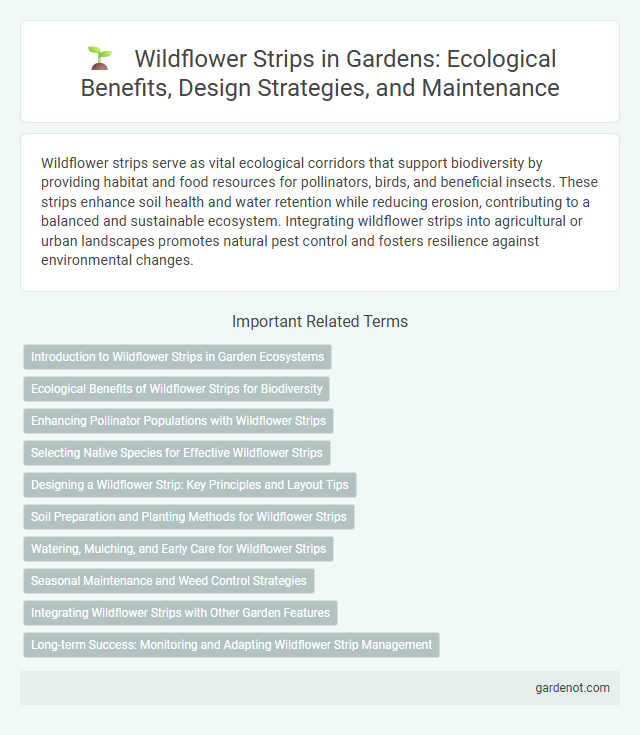Wildflower strips serve as vital ecological corridors that support biodiversity by providing habitat and food resources for pollinators, birds, and beneficial insects. These strips enhance soil health and water retention while reducing erosion, contributing to a balanced and sustainable ecosystem. Integrating wildflower strips into agricultural or urban landscapes promotes natural pest control and fosters resilience against environmental changes.
Introduction to Wildflower Strips in Garden Ecosystems
Wildflower strips enhance garden ecosystems by promoting biodiversity and supporting pollinators such as bees, butterflies, and beneficial insects. These ecological strips improve soil health through nitrogen fixation and natural pest control, reducing the need for chemical inputs. Strategic planting of native wildflowers creates habitats that maintain ecological balance and improve overall garden resilience.
Ecological Benefits of Wildflower Strips for Biodiversity
Wildflower strips significantly enhance biodiversity by providing essential habitats and food sources for pollinators such as bees, butterflies, and other beneficial insects. These ecological strips contribute to natural pest control by supporting predators and parasitoids that reduce crop pests, promoting ecosystem balance. Moreover, wildflower strips improve soil health and water retention, fostering diverse plant and animal communities that strengthen overall ecosystem resilience.
Enhancing Pollinator Populations with Wildflower Strips
Wildflower strips play a crucial role in enhancing pollinator populations by providing diverse nectar and pollen sources essential for bees, butterflies, and other pollinating insects. These ecological strips improve habitat connectivity and support biodiversity, increasing pollination efficiency in adjacent agricultural fields. Incorporating native wildflowers tailored to local ecosystems maximizes the positive impact on pollinator health and ecosystem stability.
Selecting Native Species for Effective Wildflower Strips
Selecting native species for ecological wildflower strips enhances biodiversity by supporting local pollinators and wildlife. Native plants are well-adapted to regional soil and climate conditions, promoting sustainable growth with minimal maintenance. Incorporating a diverse mix of flowering plants ensures continuous bloom cycles, providing essential habitats and food sources throughout the growing season.
Designing a Wildflower Strip: Key Principles and Layout Tips
Designing a wildflower strip for ecological benefits involves selecting a diverse mix of native flowering plants that bloom sequentially throughout the growing season to support pollinators and biodiversity. Spatial layout should incorporate varied plant heights and densities to create microhabitats, optimize sunlight exposure, and enhance soil health. Strategic positioning along field margins or waterways maximizes ecosystem services such as erosion control, habitat connectivity, and nutrient cycling.
Soil Preparation and Planting Methods for Wildflower Strips
Effective soil preparation for wildflower strips involves clearing existing vegetation, loosening the soil to a depth of 10-15 cm, and ensuring good drainage to promote seed germination. Optimal planting methods include using a seed spreader for even distribution of native wildflower seeds, followed by light raking to incorporate seeds into the soil surface without burying them too deeply. Maintaining a firm seedbed and avoiding planting during extreme weather conditions enhances establishment success and biodiversity in ecological strips.
Watering, Mulching, and Early Care for Wildflower Strips
Watering wildflower strips is crucial during the first growing season to ensure seedling establishment, requiring consistent moisture without waterlogging. Mulching with organic materials like straw or wood chips helps retain soil moisture, suppress weeds, and regulate soil temperature. Early care includes monitoring for invasive species removal and avoiding heavy foot traffic to promote healthy root development and biodiversity.
Seasonal Maintenance and Weed Control Strategies
Seasonal maintenance of a wildflower strip involves periodic mowing, typically twice a year--once in late spring and once in autumn--to promote native plant diversity and prevent woody plant encroachment. Weed control strategies include targeted hand-weeding of invasive species during early growth stages and the use of selective herbicides that minimize harm to native wildflowers. Regular monitoring during the growing season ensures timely intervention, maintaining ecological balance and supporting pollinator habitats.
Integrating Wildflower Strips with Other Garden Features
Integrating wildflower strips with garden features such as vegetable beds, pollinator-friendly shrubs, and water elements enhances biodiversity and supports ecological balance. By positioning wildflower strips alongside compost areas and native grass patches, gardeners create interconnected habitats that boost pollination and natural pest control. Strategic placement maximizes habitat connectivity, enriching both aesthetic appeal and environmental benefits in diverse garden ecosystems.
Long-term Success: Monitoring and Adapting Wildflower Strip Management
Long-term success of wildflower strips relies on continuous monitoring and adaptive management to enhance biodiversity and ecosystem services. Regular assessment of plant species composition and pollinator activity guides adjustments in mowing regimes, invasive species control, and soil health maintenance. Employing ecological indicators ensures resilience and sustainable habitat benefits over time.
Ecological strip Infographic

 gardenot.com
gardenot.com